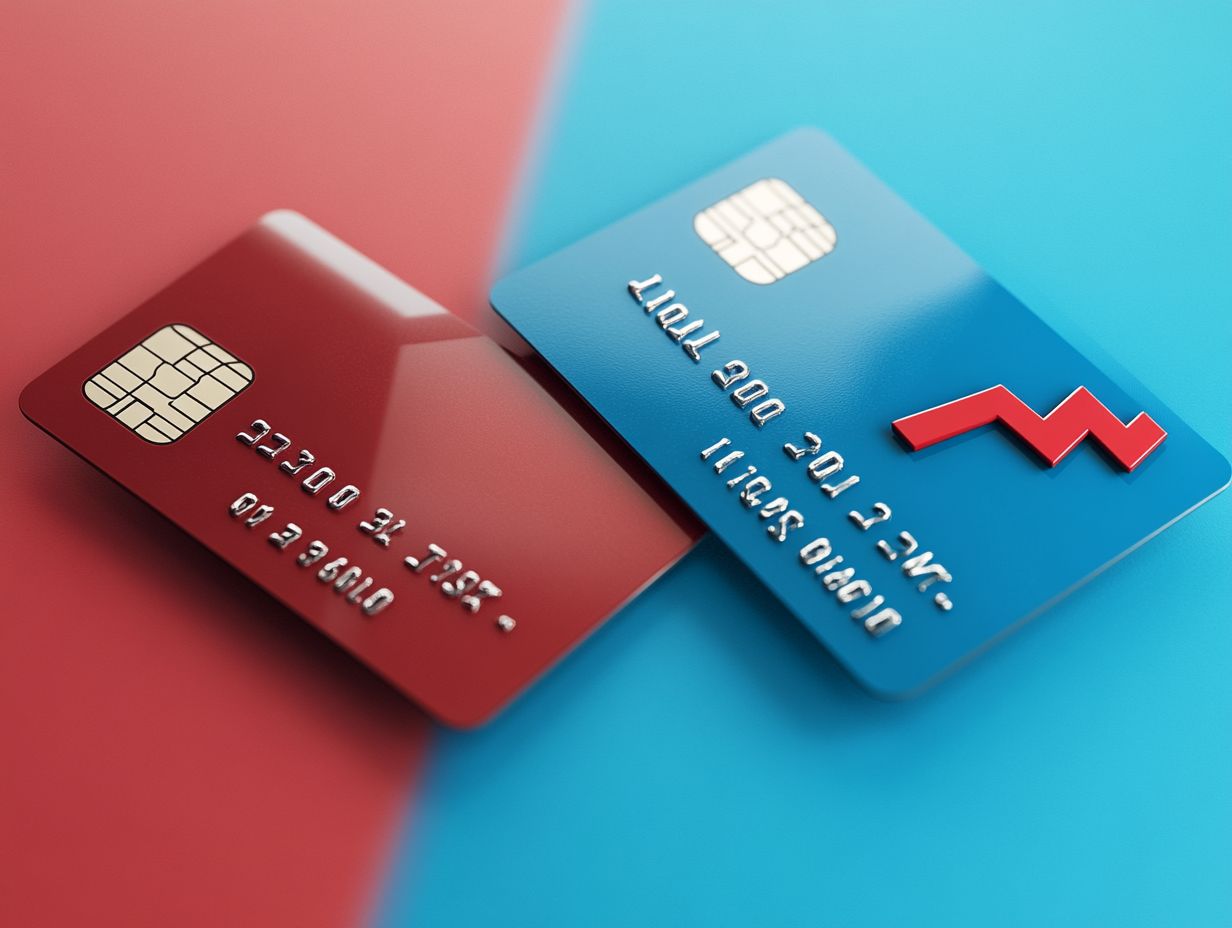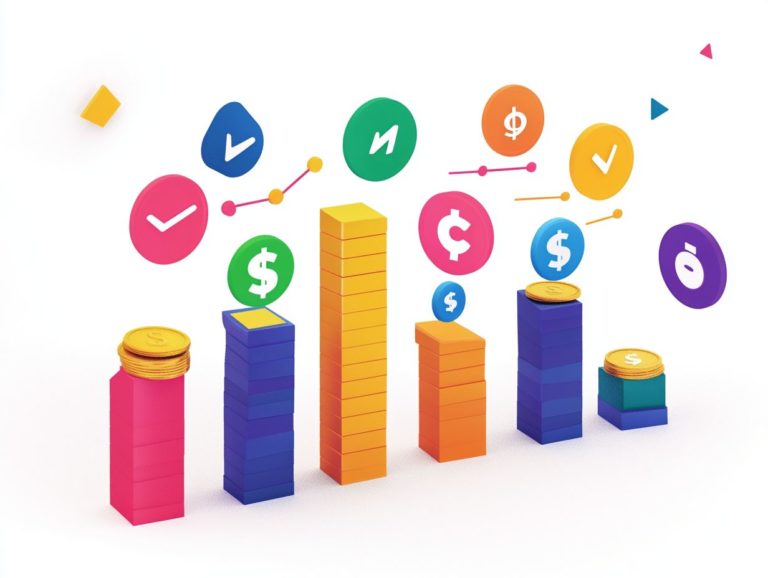Credit Card Comparison: Fixed vs. Variable Rates
Navigating the world of credit cards can be daunting, especially when deciding between fixed and variable interest rates.
Each option presents unique advantages and disadvantages that can significantly affect your finances. This article examines the stability of fixed rates versus the flexibility of variable rates, highlighting potential savings and associated risks while emphasizing crucial factors based on your financial goals.
You ll discover practical strategies for managing credit card interest rates. Immerse yourself in this exploration to equip yourself with the knowledge needed to make informed choices that align with your financial journey.
- Key Takeaways:
- Benefits and Drawbacks of Fixed Rates
- Benefits and Drawbacks of Variable Rates
- Factors to Consider When Choosing a Rate
- Tips for Managing Credit Card Interest Rates
- Frequently Asked Questions
- What is the difference between a fixed and variable rate for credit cards?
- Which type of rate is better for credit cards, fixed or variable?
- How often do variable rates change for credit cards?
- Are there any risks associated with choosing a variable rate for a credit card?
- Can I switch from a fixed to a variable rate, or vice versa, on my credit card?
- Is it possible to have both fixed and variable rates on one credit card?
- Fixed rates offer stability and predictability in monthly payments, while variable rates provide flexibility and potential for savings.
- Consider your personal financial goals and habits before choosing between fixed and variable rates for your credit card.
- To manage credit card interest rates effectively, use strategies like paying off debt, making timely payments, and monitoring your credit score.
Contents
Key Takeaways:

Understanding Fixed and Variable Rates
Understanding fixed and variable rates is crucial for you as a credit cardholder. For a comprehensive look at this topic, check out understanding credit card terms, as the choice between a fixed rate and a variable rate can significantly influence your borrowing decisions.
Fixed rates offer stability. Variable rates fluctuate with market forces, possibly affecting your monthly payments. With insights from experts like Jessica Merritt and Juan Ruiz, you can make informed decisions about your credit card options by exploring understanding credit card terms that align with your goals.
Fixed rates provide predictability, allowing you to budget effectively without the stress of fluctuating payments. Variable rates might start lower, luring you in with immediate savings, but they carry the risk of rising costs due to shifts in market conditions, like changes in the prime rate.
Understanding how these elements interact helps you determine which rate best suits your financial strategy and risk tolerance. Being aware of market fluctuations ensures you plan your finances wisely, preparing for unexpected costs or potential savings.
Benefits and Drawbacks of Fixed Rates
When considering a credit card, it’s essential to weigh the advantages and disadvantages of fixed rates. These rates typically offer a sense of stability and predictability in your monthly payments.
Fixed-rate options often include an interest rate cap, protecting you against sudden spikes in interest rates. This thoughtful approach enhances your financial planning and peace of mind.
Stability vs. Flexibility
When considering fixed rates, the discussion centers on the balance between stability and flexibility. Fixed rates offer a dependable payment structure, allowing you to manage your finances confidently. Variable rates provide the allure of flexibility, potentially leading to lower payments under favorable market conditions.
If you prioritize predictability in budgeting, fixed-rate credit cards can streamline your expenses, letting you anticipate payments without stress. If you have a steady income, now is the time to consider fixed rates for better financial management!
Conversely, if you’re open to uncertainty, variable rates might interest you, especially when market conditions favor lower rates. A frequent traveler might choose a variable rate card during promotional periods to take advantage of potential savings while remaining mindful of the risks.
This contrast underscores how varying financial profiles align with each rate’s unique benefits, allowing for personalized solutions that cater to diverse spending habits.
Benefits and Drawbacks of Variable Rates

Variable rates offer a blend of advantages and risks. If interest rates decline, you could enjoy lower monthly payments.
However, payments could rise, complicating your financial management. This can affect your overall budgeting strategy.
Potential for Savings vs. Risk of Fluctuation
The allure of potential savings with variable rates often brings along a significant risk of fluctuation. This can impact your financial stability as a credit cardholder. While a variable rate might offer lower payments during periods of declining interest rates, stay vigilant about the possibility of rising credit card fees and unexpected interest rate shifts.
For example, a sudden increase in the Federal Reserve’s interest rates could lead to a sharp rise in variable rates. This may result in payments that are higher than you initially anticipated.
To mitigate this risk, consider strategies like transferring balances to lower-interest cards. This can help lighten the load of escalating fees.
By staying informed about market trends and financial forecasts, you can make timely adjustments to your credit strategies. This ensures that you safeguard your finances against the unpredictable nature of variable rates.
Factors to Consider When Choosing a Rate
When faced with the choice between fixed and variable rates, several critical factors can profoundly influence your financial journey. Align your personal financial goals and spending habits with the type of interest rate you choose.
Your creditworthiness which reflects how likely you are to pay back borrowed money will play a significant role in determining your options from card issuers. Additionally, having a solid grasp of current market conditions enables you to make informed borrowing decisions tailored to your unique needs.
Personal Financial Goals and Habits
Understanding your personal financial goals and spending habits is essential when deciding between fixed and variable rates on credit cards. Assess your financial planning strategies and choose a credit card option that aligns with your long-term objectives and current spending patterns.
A thorough evaluation of these factors can guide you in determining whether a fixed rate, offering predictable monthly payments, is preferable for those seeking stability, or if a variable rate with potentially lower initial costs suits your tolerance for fluctuations.
It’s vital to consider how interest rates will impact your overall debt. Anticipate how lifestyle changes, like a new job or relocation, may influence your financial landscape. By analyzing current expenses and forecasting future income, you can make a well-informed decision that addresses your immediate needs and supports your greater financial ambitions.
Tips for Managing Credit Card Interest Rates

Effectively managing credit card interest rates is crucial for maintaining your financial health. It can help you steer clear of credit card debt. By employing strategic tips and insights, you can navigate your financial management journey with confidence.
You can benefit from available consumer protections and leverage the options offered by credit unions. This enhances your overall financial strategy.
Strategies for Paying Off Debt and Avoiding High Rates
Implementing effective strategies for paying off credit card debt and avoiding high-interest rates can significantly enhance your financial outlook. Consider these exciting options: balance transfers, a method that allows you to move your debt to a credit card with a lower interest rate, and taking advantage of temporary low rates two powerful ways to reduce your debt burden while minimizing those pesky interest payments.
Managing outstanding balances often involves the snowball and avalanche methods. The snowball method encourages you to tackle your smallest debts first, providing a motivational boost and helping you build momentum. The avalanche method prioritizes paying off debts with the highest interest rates, ultimately leading to greater savings over time.
Understanding how to balance these approaches based on your personal financial situation enables you to choose a strategy that aligns with your goals. By being proactive and informed about these various options, you can craft a comprehensive plan that paves the way to financial freedom and peace of mind. Start your journey to financial freedom today!
Frequently Asked Questions
What is the difference between a fixed and variable rate for credit cards?
A fixed rate means that your credit card’s interest rate will not change, while a variable rate means that it can fluctuate based on changes in the economy.
Which type of rate is better for credit cards, fixed or variable?

It depends on your personal financial situation and preference. A fixed rate offers stability and predictable payments, while a variable rate can sometimes offer lower interest rates.
How often do variable rates change for credit cards?
Variable rates can change at any time, depending on changes in the economy and the terms of your credit card agreement. It’s important to keep an eye on your interest rate and understand when and why it can change.
Are there any risks associated with choosing a variable rate for a credit card?
Yes, because the interest rate can change, there is a risk of higher payments if the rate increases. Carefully consider your budget and ability to handle potential rate changes before choosing a variable rate.
Can I switch from a fixed to a variable rate, or vice versa, on my credit card?
It depends on the terms of your credit card agreement. Some credit cards may allow you to switch between fixed and variable rates, while others may not offer this option. It’s best to check with your credit card issuer for their specific policies.
Is it possible to have both fixed and variable rates on one credit card?
No, a credit card will typically have either a fixed or variable rate, not both. However, some credit cards may offer the option to have a fixed rate for purchases and a variable rate for balance transfers or cash advances.






